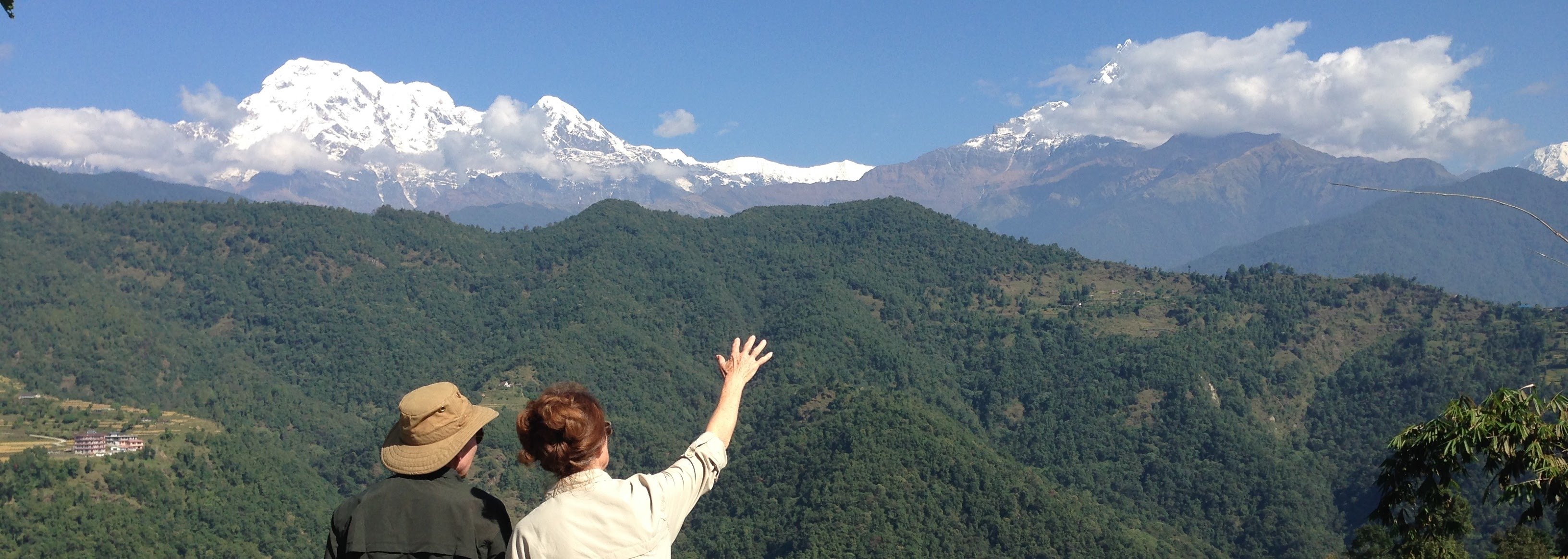
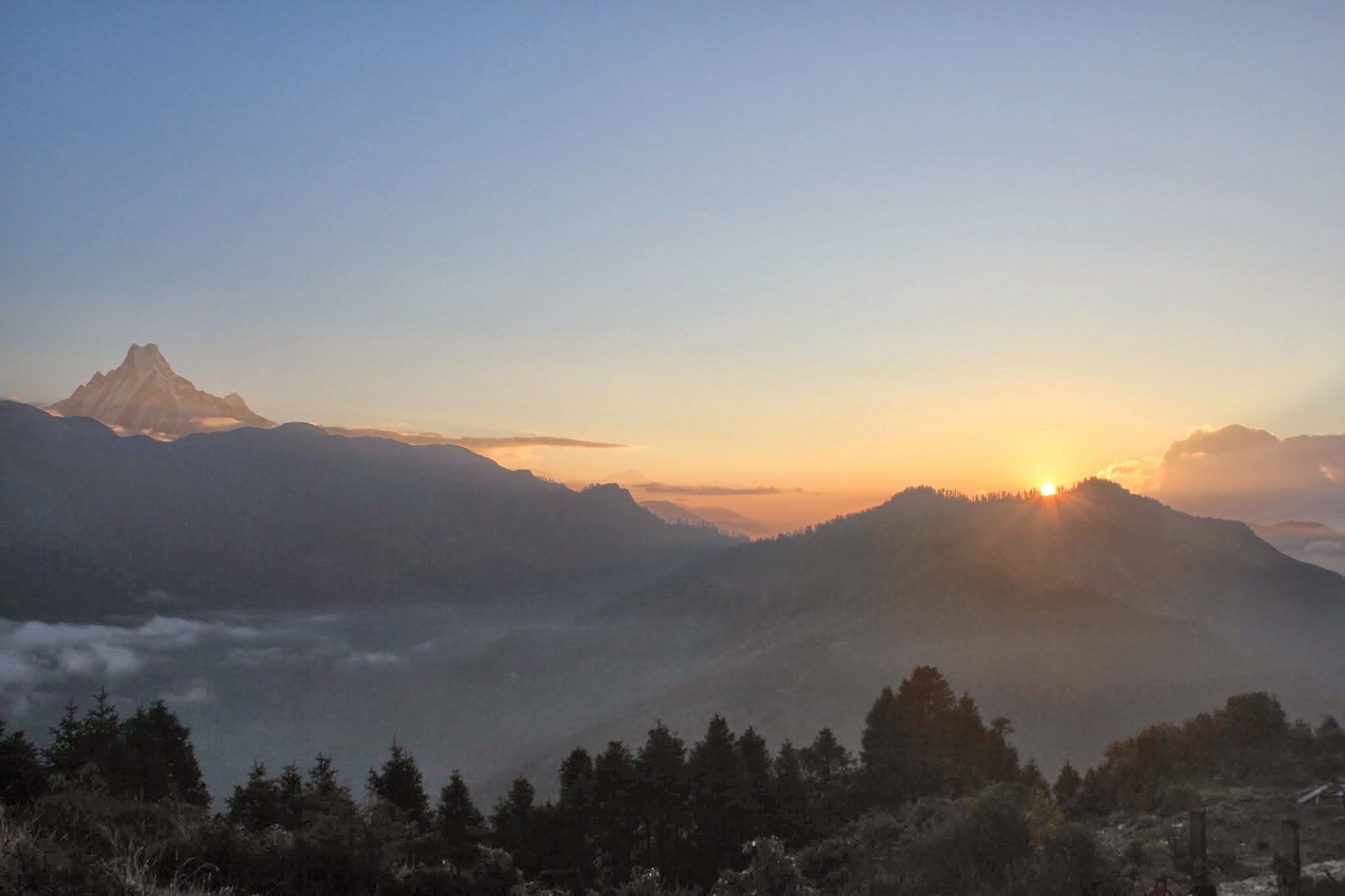
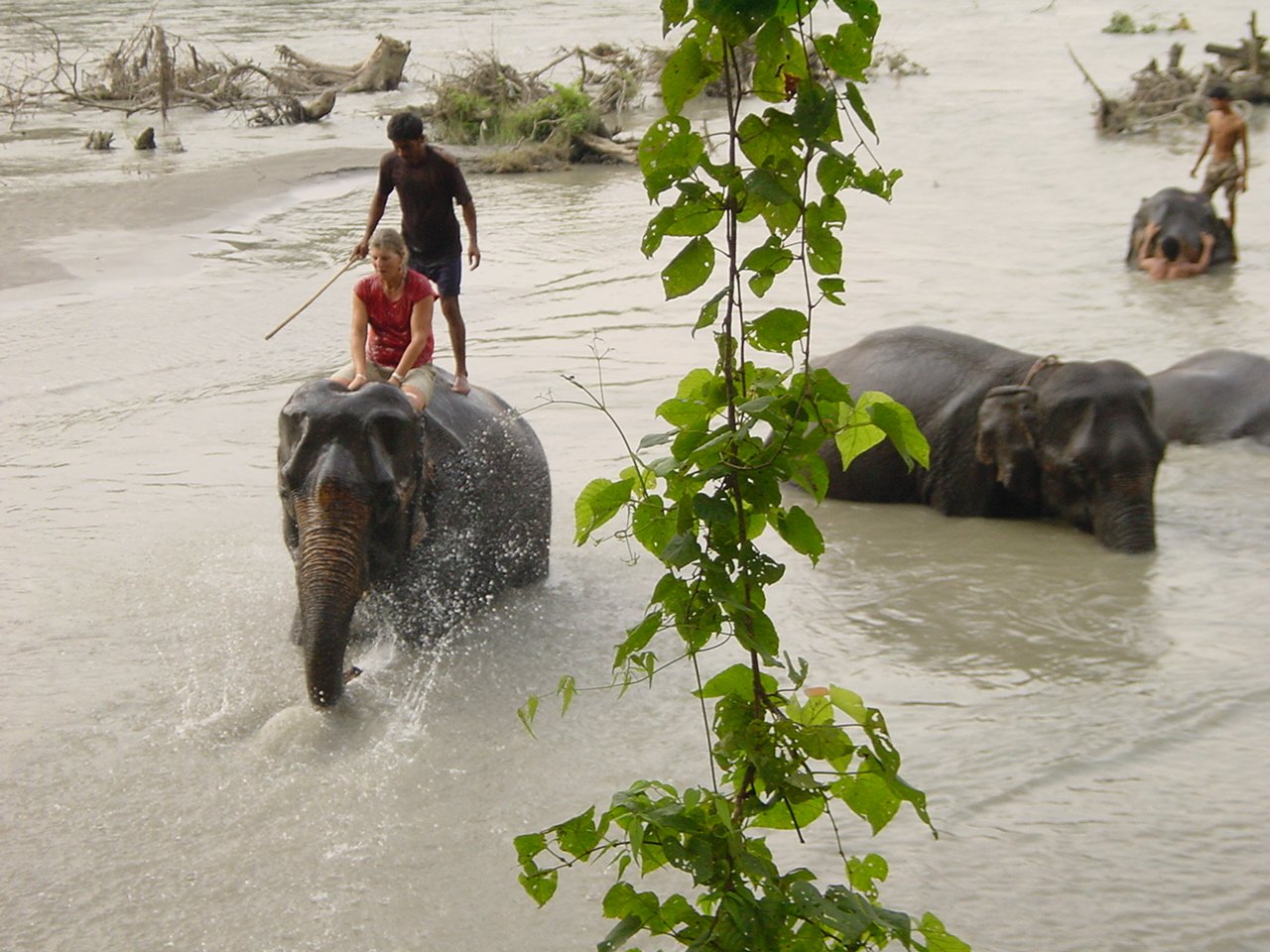
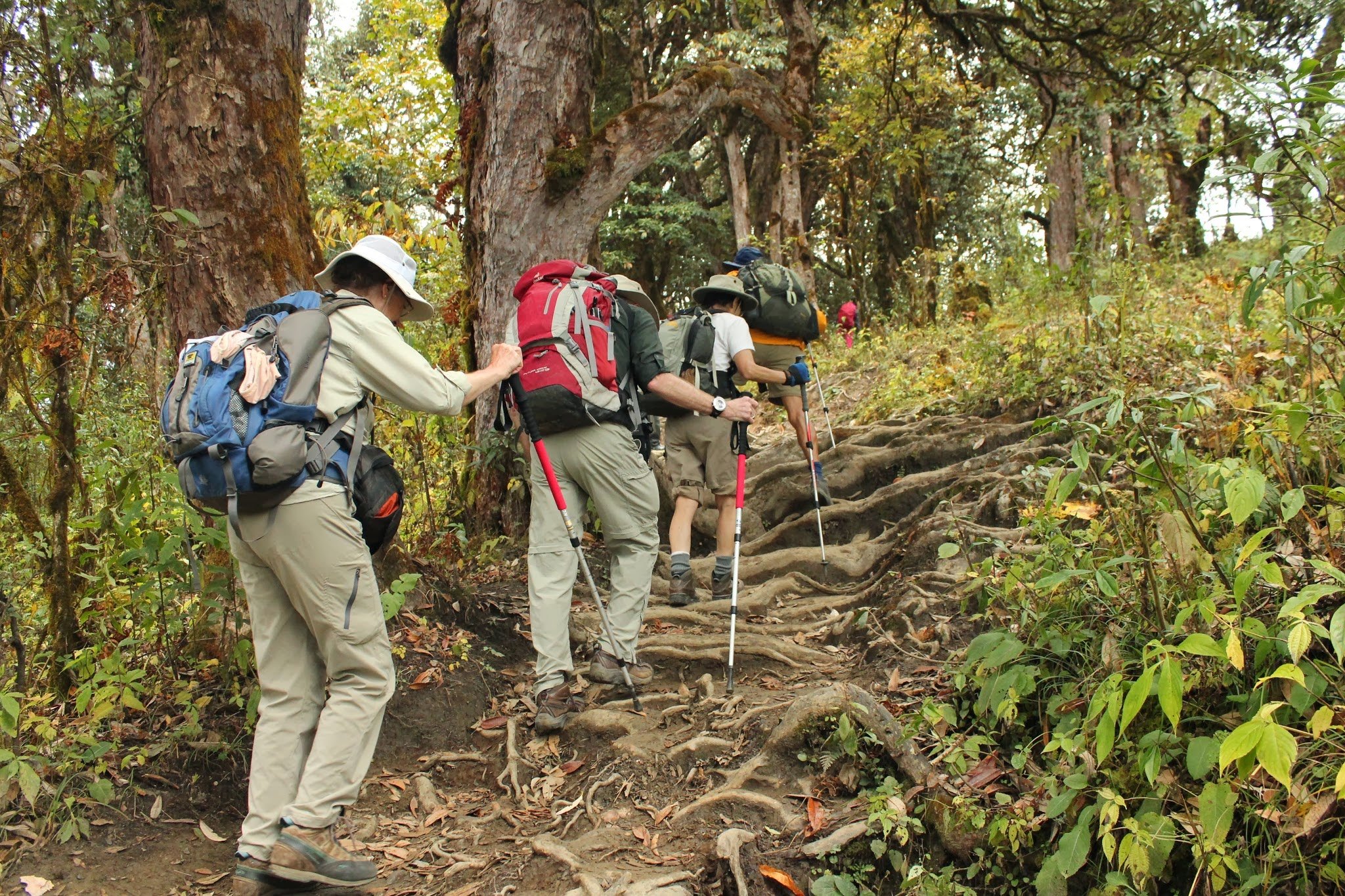
Poon Hill Trek & Chitwan Tour 17 Days
TRIP HIGHLIGHTS
- Visit the UNESCO Heritage sites
- Wildlife safaris for spot one-horned rhinoceros
- Boat ride on Phewa Lake in Pokhara
- Visit Hindu & Buddhist Temples, Monasteries
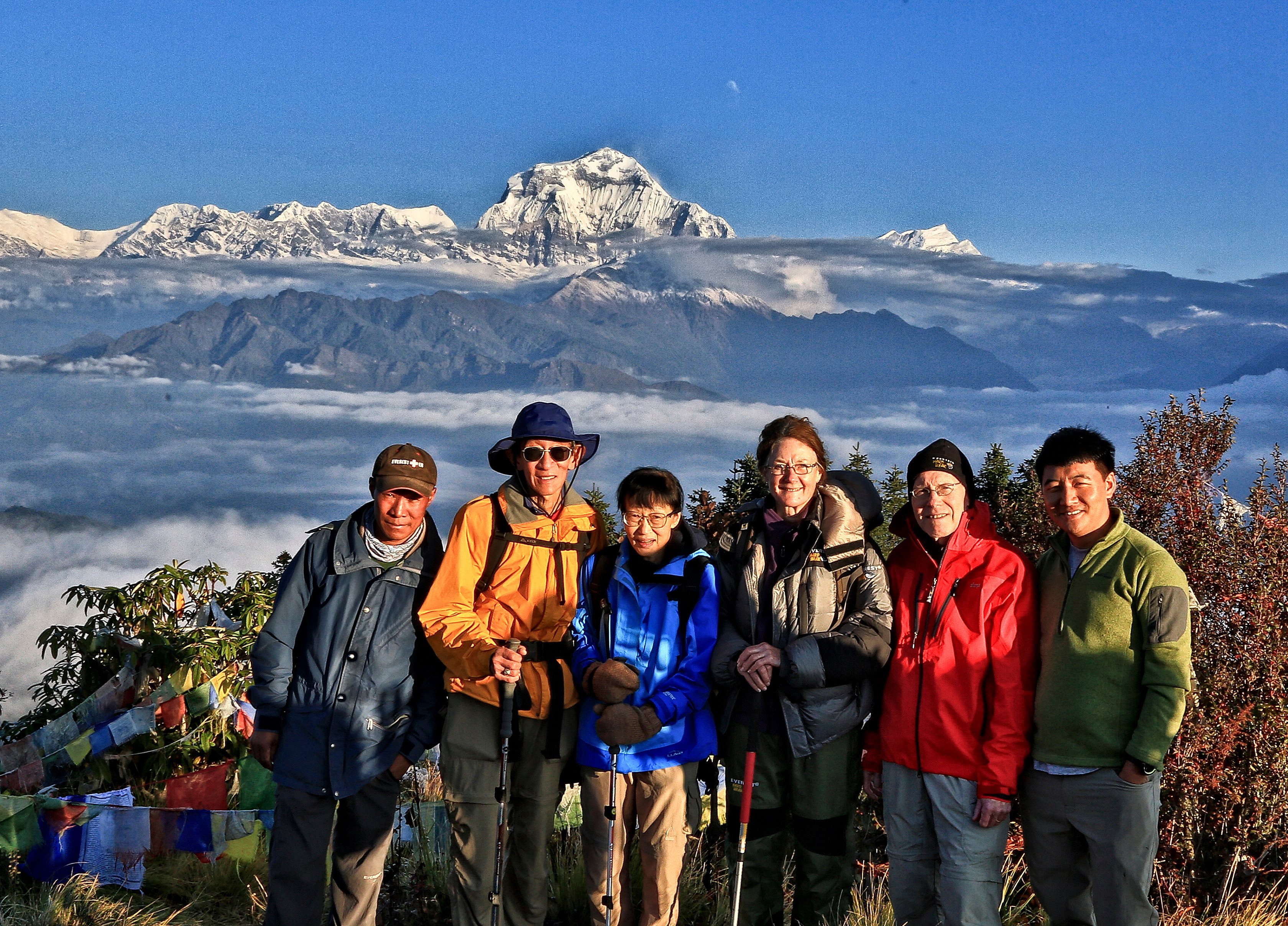
Cost From: $3750 PER PERSON
$550 SINGLE SUPPLEMENT
Return Guests get a 10% discount on all Trips!
-
Trip Type:
Tour/Trek
-
Group Size:
2-12 Trekkers
-
Best Season:
Any time
-
Max Altitude:
00 meters
00 feet -
Start-End:
Kathmandu
-
Daily Activity:
Trekking
Location:
Kathmandu, Pokhara, & Chitwan
- Fly into Tribhuvan International Airport (KTM)
We’re here to help:
Call (734) 997-7229 or E-mail.
DESCRIPTION
The Poon Hill Trek is a popular short trek in the Annapurna region of Nepal. The trek is known for its beautiful views of the Annapurna mountain range, including Annapurna South, Annapurna I, and Dhaulagiri. Its cultural experiences as it passes through traditional Gurung villages.
The Poon Hill Trek typically starts in Pokhara and takes about 3-4 days to complete. The trek follows a route that passes through forests, fields, and villages and reaches an elevation of 3,210 meters (10,530 feet) at Poon Hill. Along the way, you can visit monasteries and temples and interact with the local Gurung community.
Bandipur is its old town, home to traditional Newari houses and temples. The city is also home to the Bandipur National Park, a protected area for various species of wildlife, such as leopards, deer, and pangolins.
Chitwan, located in south-central Nepal, is home to the Chitwan National Park, a protected area known for its diverse wildlife and opportunities for safari tours and elephant rides. The park is home to species such as one-horned rhinoceroses, Bengal tigers, and various species of birds. This trip is perfect for family and people who dislike trek.
TRIP ITINERARY
DAY- 1: ARRIVE IN KATHMANDU:
Book your flight for Tribhuvan International Airport (KTM) as your itinerary. Your guide will pick you up and transfer you to your hotel. She/he will brief you about your next day's schedule.
Accommodation: Hotel Tibet
DAY- 2: KATHMANDU SIGHTSEEING
After breakfast, your guide will pick you up to explore Kathmandu. Three primary Kathmandu heritage sites, Baudhanath, one of the largest Buddhist stupas in the world. Pashupatinath is a Hindu temple dedicated to Lord Shiva. This temple was classified as a World Heritage Site in 1979. and Kathmandu Durbar-Square is an old royal palace of the former Kathmandu Kingdom. Evening welcome dinner with the group briefs you about the next day’s activities.
Accommodation: Hotel Tibet
Meals included: Breakfast/Dinner
DAY- 3: FLIGHT TO Pokhara
After breakfast, Fly to Pokhara evening walk around town or take a boat in the lake.
Accommodation: Fishtail lodge
Meals included: Breakfast/Lunch/Dinner.
DAY- 4: Drive to Nayapul and trek to Ulleri
After breakfast, we catch our jeep and around 2 -3 hours’ drive to Nayapul, where we begin our trek. Walking along side by side of roads and river for a few hours, we stop at Tirkhedunga for lunch. After lunch and crossing the suspension bridge we start a steep climb approx. Three hours to reach Ulleri.
Accommodation: Local Tea house
Meals included: Breakfast/Lunch/Dinner
DAY- 5: Trek from Ulleri to Ghorepani
Ascend to Ulleri Village through a pleasant rhododendron forest. At the beginning of April, you witness the blossom of rhododendron flowers. Crossing a small stream and bridge, we arrived at Ghorepani.
Accommodation: Tea House
Meals included: Breakfast/Lunch/Dinner
DAY- 6:Trek from Poon Hill to Dobato
Starting early morning around 1 hour ascend to Poon Hill for sunrise and back to the hotel and walk towards the southeast Ghorepani. A few hours climb and walk in Jungle you are at Dobato for tonight.
Accommodation: Tea House
Meals included: Breakfast/Lunch/Dinner
DAY- 7: Dobato to Kopra Danda
As we ascend continuously toward Kopra, we can see stunning views of the mountain ranges, including Annapurna South, Dhaulagiri, and Nilgiri.
Accommodation: Tea House
Meals included: Breakfast/Lunch/Dinner
DAY- 8: Hike to Khayar Lake and back to Kopra Danda
Leaving our bags in the hotel, after breakfast we ascent to our highest viewpoint and one of the most beautiful lakes in this region Khayar Lake
Accommodation: Tea House
Meals included: Breakfast/Lunch/Dinner
DAY- 9: Kopra Danda to Narchyang Village
From Kopra Danda the trail descends rapidly to Narchyang Village, one of the biggest Magar villages in this area. Tonight, we stay at a Local lodge or Homestay.
Accommodation: Tea House
Meals included: Breakfast/Lunch/Dinner
DAY- 10: Narchyang Village to Tatopani and drive to Pokhara
After a short walk down from the village, we are now at Tatopani. Our last point of Trek, where we back to Pokhara via Jeep or Bus.
Accommodation: Tea House
Meals included: Breakfast/Lunch/Dinner
DAY- 11: Drive to Bandipur
2 & half hour drive under normal road conditions. Upon arrival in Bandipur, transfer to Hotel. Afternoon: Walking tour of Bandipur Bazaar
Accommodation: Tea House
Meals included: Breakfast/Lunch/Dinner
DAY- 12: Drive to Chitwan
After breakfast, drive to Chitwan, Lunch, Village tour on Ox cart, and Dinner.
Accommodation: Green park
Meals included: Breakfast/Lunch/Dinner
DAY- 14: Jeep Safari
Canoe Ride, Nature walk Visit to the Elephant breeding center, Lunch, Jeep safari Tharu cultural program Show.
Accommodation: Green park
Meals included: Breakfast/Lunch/Dinner
DAY- 15: Elephant back Safari
Bird Watching, Lunch, Elephant Back Safari
Accommodation: Green park
Meals included: Breakfast/Lunch/Dinner
DAY- 16: Fly Back to Kathmandu
After breakfast, fly back to Kathmandu.
Accommodation: Hotel Tibet
Meals included: Breakfast/Dinner
DAY- 17: FINAL DEPARTURE:
Our office staff will drop you at the airport 3 hours before the flight schedule.
Meals included: Breakfast
Dates & Prices
TRIP DETAILS
WHAT'S INCLUDED
• Standard hotels in Kathmandu, Chitwan, Pokhara, and Local guesthouses during the trek.
• All listed transport and activities.
• All meals during the trek ( Breakfast, Lunch & Dinner)
• Trekking permit and national park fees.
• Arrival and departure transfers.
• Experienced Trekking guide and other support staff.
• Proper Insurance of all local staff, including porters.
• Entry fees in a Heritage site in Kathmandu as per itinerary.
WHAT'S NOT INCLUDED
• Personal Travel and Medical Insurances.
• Personal Trekking Gear and Equipment.
• International flight tickets.
• Lunch and Dinner in Kathmandu.
• Visa fees and vaccination
• Trek guide and porter tips
• Alcohol drinks
WHAT GEAR TO BRING
Once you book this trek you’ll receive access to a printable, downloadable trip information packet with a detailed packing list
FAQ
How do I sign up for a trip?
Booking a trip is easy. Call us at 734-997-7229 or 303-834-5512, or Email us at info@imperialexpedition.com.
Online bookings are made via the ‘Book Now button available on each trip page. Once we confirm your booking, we’ll send you comprehensive information regarding visas, vaccinations, gear, clothing, and arrival details to ensure you are fully prepared for your adventure.
How fit do I need to be to trek in the Himalayas?
You should be moderately fit, exercise regularly, and enjoy active vacations and walking and hiking in mountainous terrain. For the Everest base camp trek, you should be able to run for an hour without stopping at any speed and still feel good to continue – OR – walk for 5-6 hours in a day with rests. Trekking is an endurance sport. Mostly you need a good attitude, which will go a long way toward the success of reaching your goal.
When is the best time to trek and climb in the Himalayas?
-
Fall (September-November): Fall is considered the best time for trekking in Nepal. The weather is excellent at this time, allowing for clear blue skies and tantalizing mountain views. Temperatures are moderate. Occasional short storms may bring snow to higher altitudes.
-
Winter (December-February): Winter brings heavy snowfall mostly at higher altitudes. This can be a good time for cultural tours and trekking at lower elevations.
-
Spring (March-May): Spring is a good time for trekking and climbing in Nepal and Tibet. The rhododendrons, the national flower of Nepal, make the hillsides a colorful paradise during the spring. It is mildly warm at lower elevations and at higher elevations, the mountain views are excellent while the temperature is quite moderate. If you trek to Everest base camp in the spring, you will have the opportunity to meet world-renowned climbers, as several Everest expeditions will be assembled at base camp.
-
Summer/Monsoon (June-August): The monsoon during the summer months can make travel in Nepal wet, muddy, warm, and often humid. Strong monsoon rains don’t usually last long, and often end with large and wonderful rainbows. However, the streets in Kathmandu can be muddy and landslides sometimes occur in the mountains. It is recommended to carry insect repellent when trekking during these months.
What sort of experience do your guides have?
Our guides are dependable, competent, and highly qualified with more than ten years of trekking experience, leading trips, treks, climbs, and expeditions in the Himalayas. Our guides speak English and the local language. We are trained in first aid and CPR. Most importantly, our guides are friendly and enjoyable and are passionate about sharing the rich cultures, traditions, and natural beauty of Nepal.
What is the routine on the trek?
Most trekkers normally start their day early around 7:30 to 8:30 am after a hot breakfast. The morning sun offers nice mountain views. You will carry a light pack for your camera, water, a jacket, and a wind layer. Around noon we will reach the lunch stop where we will spend time drinking tea, resting, and having lunch. After lunch, we normally walk for 2 to 3 more hours before arriving where we will stop for the evening. Here at the lodge we will have hot tea and relax for the rest of the day. Our day ends with dinner and then off to bed in single or double rooms in the trekking lodge.
What type of shoes or boots should I wear?
The proper footwear depends on the trek and on the trekker. Most hikes can be done in comfortable running shoes while longer more strenuous treks may require sturdy but lightweight hiking boots. It is best if you purchase shoes and boots long before arriving in Nepal. We advise that you wear your boots prior to the trek to break them in – in order to prevent blisters, which can be debilitating on the trail.
How big will the group be?
We try to bring together a small group of like-minded people. Our trekking groups are generally from 6 to a maximum of 12 members, although we can accommodate smaller groups and solo trekkers as well.
Do you arrange private or family treks?
Yes, if you would like to travel independently or with friends, family or colleagues, you are invited to choose the trip that best suits your group and the trip dates according to your schedule. We are happy to consider any number of trekkers. Our maximum is not more than 50 at a time. The cost per person for private trips is negotiated on the basis of group size, trek area, and duration.
How long do we walk each day?
Our trips are classified into three categories according to the level of difficulty. Easy adventure treks are about a week to 10 days in duration. They generally don’t go above 13,000 feet (4,000m). You can expect to be hiking/walking for around 4-5 hours a day. Moderate to fairly challenging treks are longer treks that go into a high mountain country above 13,000 feet (4,000m). Physically these trips are more demanding and tiring and may involve 6-8 hours of trekking along rocky trails in high Himalayan terrain. Strenuous treks are longer treks that go beyond the normal activities of trekkers and tourists. These include ice climbing and mountaineering expeditions. Physically challenging, these trips may involve 7-9 hours of trekking in a day and are likely to include unfavorable weather conditions and strenuous activities. Some level of experience may be required for these trips.
What type of food is served during a trek?
In general, while trekking breakfast may include a choice of porridge, muesli, omelet, fried or scrambled eggs with chapattis or bread. Lunch and dinner are generally pasta, potatoes, or rice with or without cooked veggies and/or eggs. Meat is also available, however, it is recommended to adopt a vegetarian diet. As long as the meat is stored and cooked properly, meat dishes are also safe. Tea, coffee, and hot chocolate are available at all meals. Your guide will do his/her best to make sure all food is well cooked. At some restaurants in Kathmandu, the vegetables are soaked in iodine and thus fresh salads are safe to eat. While trekking it is best to avoid raw vegetables unless you can peel them yourself. The rule is: cooked, peeled, boiled – or forget it! During the trek, you can choose what you like from the menu in the lodge. There will also be plenty of snacks available such as biscuits, popcorn, candy bars, and soft drinks. In some areas, you will find fresh fruit in season.
What if I have to cancel?
If you decide to cancel your trip, the following fees apply and are due to Imperial Expedition prior to departure when we receive written notice of your cancellation. Cancellation Fee Schedule for tours and treks:
- 90-81 days prior to departure You forfeit half the deposit
- 80-60 days prior to departure You forfeit the deposit
- 59-31 days prior to departure You forfeit 50% of the total amount
- 30 or fewer days prior to departure You forfeit the entire cost of the trip
Cancellation Fee Schedule for Climbing Trips and Expeditions:
- 180-150 days prior to departure You forfeit
- 149-89 days prior to departure You forfeit 50% of the total amount
- 90 or fewer days prior to departure You forfeit the entire cost of the trip
What are the overnight accommodations like?
In cities, you will be staying in hotels and guesthouses that are similar to those in the US with private bathrooms, showers, TV, phone, AC, etc. If you prefer luxury hotels we can make those arrangements as well. While trekking in the mountains the accommodations will depend on whether you are camping or teahouse trekking. If you are on a camping trek, then you will be sleeping in a tent. The trekking lodges or teahouses are simple shelters. There is no central heat. In the dining room where meals are served, there is often a wood-burning stove that heats that room only. The guest rooms are not heated so you will need a good quality sleeping bag, which can be rented in Kathmandu. The guest rooms are usually small and sleep one or two trekkers. The walls are thin so earplugs are a good idea for light sleepers. The bathrooms are down the hall or outside. Nowadays, there are also a few ‘luxury’ establishments along the popular trekking routes. If you are interested to upgrade, let us know and we can make those arrangements.
What happens in case of an emergency?
In the case of a serious illness or a life-threatening emergency during your trek, a helicopter rescue will be initiated. You are responsible for all the expenses incurred in such an evacuation. It is required that you have insurance that covers emergency helicopter evacuation throughout your trip. However unlikely, we are prepared for emergencies, and your guide will respond quickly to get any necessary medical help. We aim to avoid such circumstances with education and a large dose of preventative medicine.
Can I get a Nepal visa on arrival?
Yes! A Nepal visa is easily available upon arrival at the entry places. Make the process easier by downloading & completing the application form, having the correct USD cash, and two passport photographs.Visa FacilityDurationFee
Multiple entry15 daysUS$ 25 or equivalent Nepali currency
Multiple entry30 daysUS$ 40 or equivalent Nepali currency
Multiple entry90 daysUS$ 100 or equivalent Nepali currency
Custom Declaration on Kathmandu, Nepal Arrival (For Foreign Nationals)
1. Travelers are required to declare goods in excess of permitted personal effects
and duty-exempted consumable goods and restricted/prohibited goods and commercial
goods at the red channel. Travelers possessing such goods may use the green channel.
2. Export or import of narcotics, arms and explosives, wildlife and its products, and
commercial goods are restricted/prohibited. Attempt to import or export such goods
may lead to confiscation of goods, penalty, and arrest resulting in prosecution.
3. Travelers are required to declare foreign currency at the red channel if the sum exceeds
US$2000 or equivalent.
4. Permitted used personal effects are as follows in condition to return back at the time
of departure:
1. Binocular one set.
2. Video Camera and still camera one set each.
3. Portable music system one set recorded media 10 pcs.
4. Cloths and goods of day-to-day use.
5. Perambulator and tricycle one set each.
6. Bicycle one set.
7. Watch one piece.
8. Cellular mobile phone one set
9. Professional hand tools are one set for professional personnel.
5. Duty-exempted consumable goods are as follows:
1. Whiskey/wine not exceeding 1.15 liters or beer up to 12 cans.
2. Cigarettes 200 sticks, cigar 50 sticks, tobacco 250 grams.
3. Camera film up to 15 pcs and movie film 12 reels.
4. Readymade and can foods not exceeding NRs.1000.00.
5. Medicine not exceeding Nrs.1000.00.
6. Fresh fruits not exceeding NRs.1000.00
Is it possible to deviate from the itinerary?
Our specific itineraries are custom crafted with you in mind. Once we agree on a plan, we can always make minor changes and adjustments while en route. The itinerary acts as a general plan for the trip. However, there are often local events, festivals, or happenings that may capture our attention. As long as everyone in the group agrees on these changes, that is fine. Major changes to the itinerary may be made if there are political or environmental concerns. Your guide will help to make any necessary adjustments. Our trips are adventures that may take you into remote regions where unforeseen circumstances may contribute to the need for a change in the itinerary.
Any suggestions on what to do and what not to do with respect to the Nepalese culture?
Nepal has many diverse ethnic groups, traditions, and religions. There are numerous cultural practices that may appear unusual to a person on his/her first visit to the country.
- The most common greeting in Nepal is “Namaste” which is performed by placing the palms together and bowing as if praying.
- Before entering a Nepalese home, temple or monastery remember to remove your shoes and place them neatly side-by-side.
- Be careful not to use your spoon, fork, or hands to touch another person’s food, plate, cooking utensils, or even the serving dish. Do not eat from other people’s plates and do not drink from other people’s water bottles or glasses. This is considered to be impure by the Nepalese.
- Never touch anything with your feet. The feet and the floor are considered dirty.
- While traveling, dress appropriately. Women should avoid short skirts and sleeveless shirts.
- Seek permission before entering a Hindu temple. Many Hindu temples do not allow non-Hindus to enter.
- Leather is prohibited inside temples because cows are considered sacred and are not used for slaughter.
- Walking around temples or Buddhist stupas is traditionally done clockwise.
- Be sure to ask before taking photographs of the locals. Some people believe part of the soul is taken when a picture is snapped.
- Public displays of affection between a man and a woman are frowned upon and are not generally accepted.
- When the Nepalese shake their head from left to right, they may mean, “Yes”.
- Develop a genuine interest in Nepal and meet and talk to the Nepalese people. Do your best to respect their local customs and traditions.
Payment methods
For your convenience, we have different methods of payment as mentioned below. You can choose any of these methods:
1. Bank Transfer (ask for account info)
2. Mail a check made out to 'Imperial Expedition' to Imperial Expedition 218 S. Main St. Ann Arbor, MI. 48104
3. You can also pay by credit card, over the phone or online
What about transferring trips?
Tours and trekking trips may be transferred to the next year or to another date, however, the transfer must be made 90 days or more prior to departure. Otherwise, if the transfer is made 90 days or less prior to departure, you must pay the cancellation fees as outlined above. There are no fees for transferring trips more than 90 days prior to departure. However, for climbing trips and expeditions, if you would like to transfer your trip to the next year or to different dates, there is an automatic transfer fee of $1,000 that must be paid to Imperial Expedition.
Should I purchase trip cancellation insurance?
If you must cancel your trip due to illness, injury, or death of yourself or an immediate family member, trip cancellation insurance protects all your deposits and payments for both air and land costs. It is recommended that you buy trip cancellation insurance but not required.
What if Of Imperial Expedition cancels my trip?
Imperial Expedition reserves the right to cancel all or a portion of a trip due to political or environmental circumstances, which may hinder trip operations or for any other reasons beyond our control. In the event of such a cancellation, we will give a full refund for the cost of the trip. However, Imperial Expedition is not responsible for additional expenses incurred by you in preparing for the trip, visa fees, gear, insurance, or medical expenses prior to the trip. If international air tickets have been purchased, the airline’s refund policy applies.
What other expenses should I consider?
Medical advice and inoculations, health and travel insurance, travel and trekking gear, international airfare, Nepali visas, airport tax, spending money, and most meals are not included in the cost of your trip.
How much should I budget for tipping?
Your support team will work hard to please you during your trip. They will appreciate receiving a tip at the end of their service. The amount you give depends on you and your appreciation of their work. We recommend giving from $200 – $300 total in tips to your porters.
Electricity in Nepal
Residential electrical outlets in some countries including the United States use 110-120 volts of electricity and accept very specific shaped plugs. Many other countries including Nepal use other voltages, 220-240 volts to power their appliances, as well as different plugs. If you try to plug an American appliance such as a shaver or hair dryer into an outlet of a different voltage, you may destroy the appliance and cause yourself injury. There are a few things you should know about other countries (here Nepal) before you travel.
Contact Us
We are always available to answer your questions. Please let us know what’s on your mind. Good communication is important for a safe and fulfilling trip! Send us a note or call us directly:
Name: Pem Dorjee Sherpa
Phone: 303-834-5512
Email: info@imperialexpedition.com
ACCOMMODATIONS
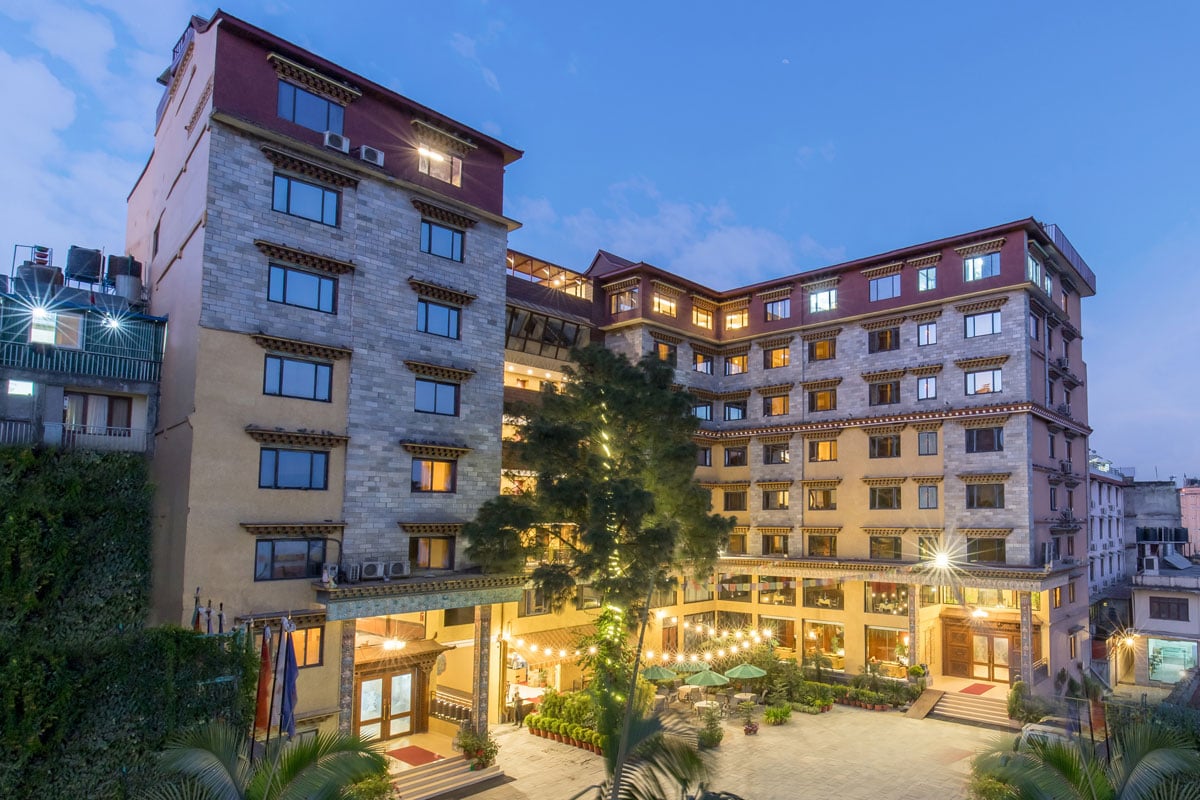
Hotel Tibet International
3 NIGHTS
Walking distance from the UNESCO Heritage Site of Boudhanath Stupa, Hotel Tibet International is a 4-star standard boutique hotel that showcases the Tibetan-Buddhist culture and heritage in Kathmandu. Inspired and decorated in Tibetan style.
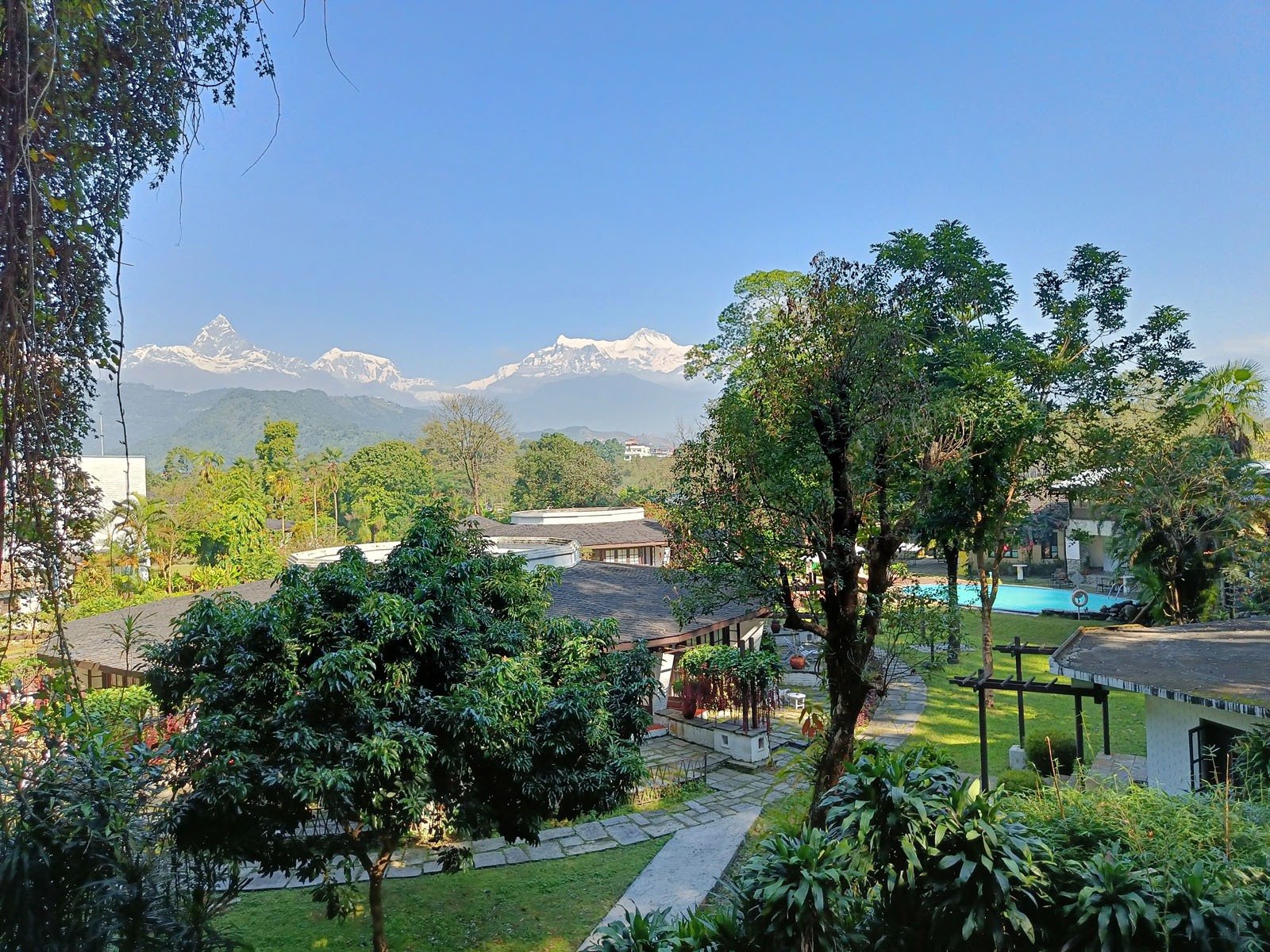
Fish Tail Lodge
2 NIGHTS
Fish Tail Lodge enjoys a unique location on a peninsula across Fewa Lake. Shuttle floats or boats transport you across to the resort. The views are spectacular, with the lake on one side and a forested hill on the other. The panorama of the Annapurna range and Mount “Machhapuchre” (Fish Tail) and their reflection on the lake soothe your soul and refresh your spirit.
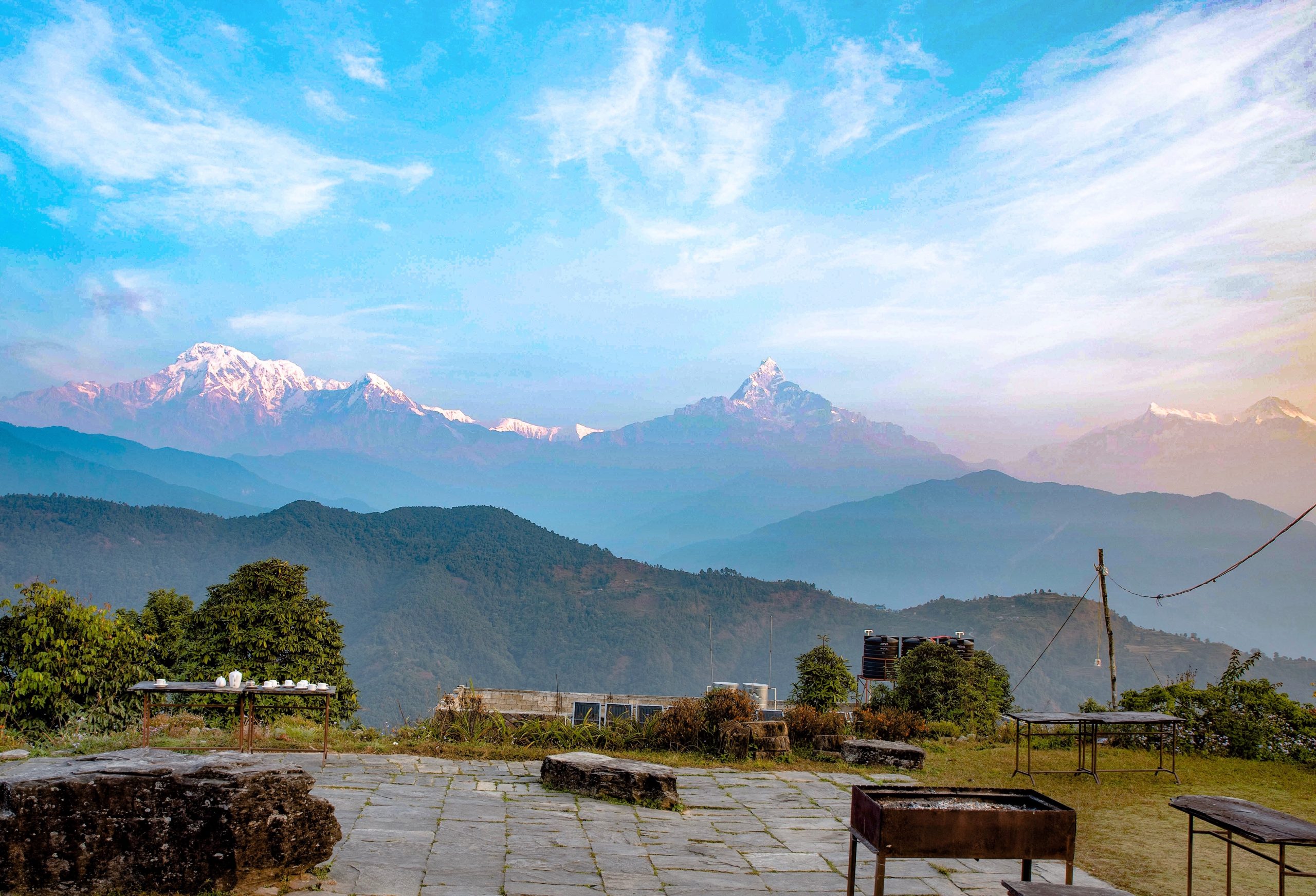
LOCAL GUEST HOUSE
6 NIGHTS
Tea houses are accommodations along trekking routes in Nepal that offer basic lodging and meals. All tea houses own and operate by local families. Every tea house has one large communal dining area with a wood-burning stove in the center. It’s a great spot to meet other trekkers, swap stories, warm up, and sip tea while you watch the sunset over the mountains.
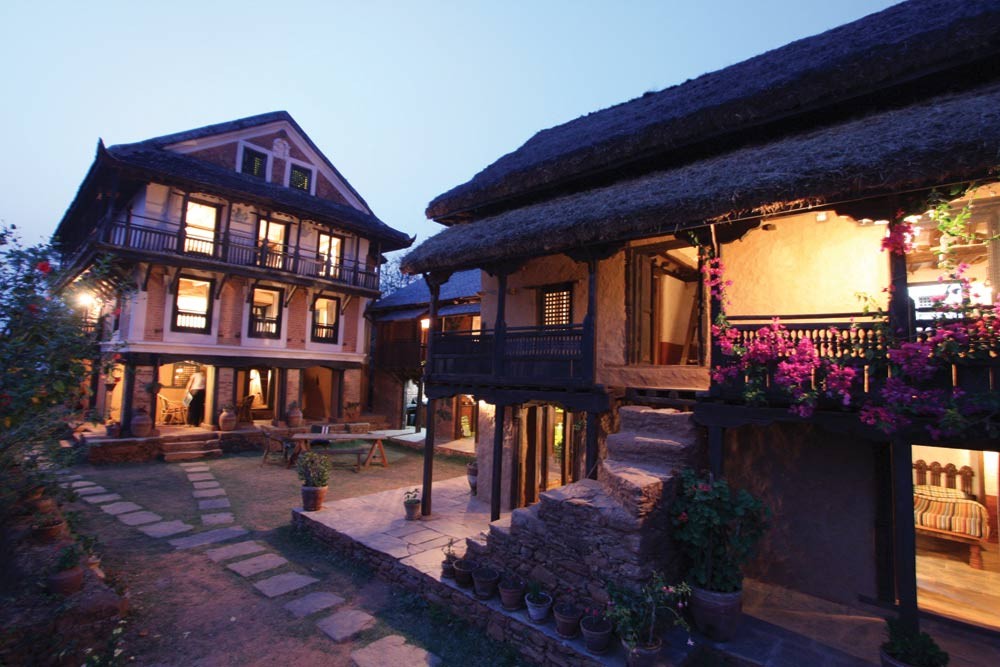
The Old Inn, Bandipur
1 NIGHT
Explore ancient Newari towns, discover rural Nepal's pastoral delights, and enjoy the comforts of our most appealing and well-appointed boutique-style guesthouses. Each pays homage to Nepal’s rich cultural heritage, yet they are also endowed with 21st Century comforts. For something completely different, we also have a fun riverside eco-camp!
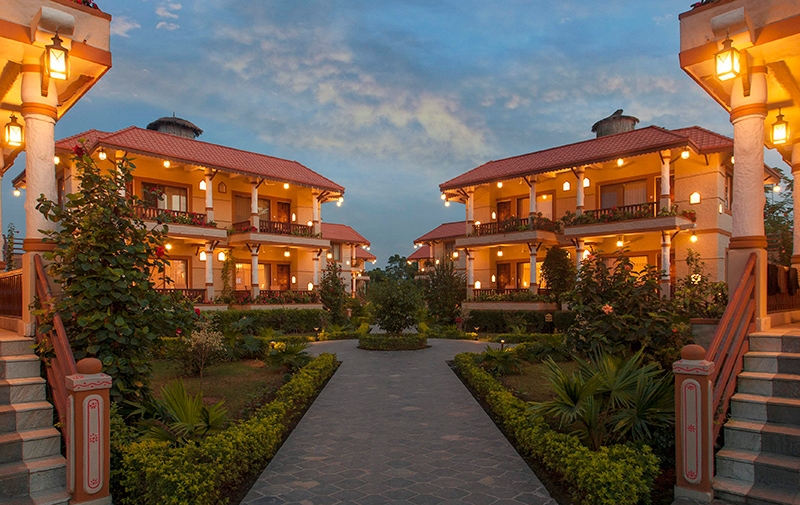
Green Park Chitwan
3 NIGHTS
The best resort in Chitwan with luxurious appurtenance and A homely atmosphere. We have ensured that all our rooms have a touch of the Chitwan culture, art, and vibes. Also, the rooms have a vibrant ambiance of jungle life, giving you a feel of the jungle within a serene environment. Not to forget the comfort and hospitality we offer, making you feel at home away from home.
These exact accommodations are not guaranteed. In some instances alternative accommodations of similar quality and location may be used.
